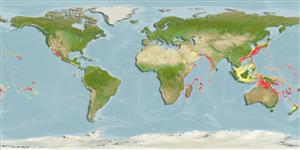>
Aulopiformes (Grinners) >
Synodontidae (Lizardfishes) > Synodontinae
Etymology: Synodus: Greek, syn, symphysis = grown together + Greek, odous = teeth (Ref. 45335); doaki: Named after Wade Doak, pioneer New Zealand diver and underwater naturalist who first discovered this fish at the Poor Knights Islands..
Environment: milieu / climate zone / depth range / distribution range
Ecología
marino asociado a arrecife; rango de profundidad 9 - 260 m (Ref. 58302). Temperate
Indo-Pacific: East Africa, Japan, Chesterfield Islands (Ref. 11897), eastern Australia, northern New Zealand (Ref. 9818) and Hawaiian Islands (Ref. 58302). Southeast Pacific: Nazca and Sala-y-Gomez (Ref. 50546).
Tamaño / Peso / Age
Maturity: Lm ? range ? - ? cm
Max length : 28.0 cm TL macho / no sexado; (Ref. 2334)
Espinas dorsales (total): 0; Radios blandos dorsales (total): 13-15; Espinas anales 0; Radios blandos anales: 8 - 9. Cheek scaled to margin of preopercle; flap on anterior nostrils very long and rounded; pectoral fins reaching a line connecting origins of dorsal and pelvic fins. The irregular bars and spots on the body red, the centers of larger markings sometimes yellow. All fins with transverse red bands.
Benthic (Ref. 58302). Inhabits sandy bottoms close to rock or coral outcrops. In New Zealand, frequently seen in pairs (Ref. 9818).
Life cycle and mating behavior
Madurez | Reproducción | Puesta | Huevos | Fecundidad | Larva
Randall, J.E., G.R. Allen and R.C. Steene, 1990. Fishes of the Great Barrier Reef and Coral Sea. University of Hawaii Press, Honolulu, Hawaii. 506 p. (Ref. 2334)
IUCN Red List Status (Ref. 130435)
Threat to humans
Harmless
Human uses
Más información
Nombres comunesSinónimosMetabolismoDespredadoresEcotoxicologíaReproducciónMadurezPuestaAgregación para la puestaFecundidadHuevosEgg development
ReferenciasAcuiculturaPerfil de acuiculturaRazasGenéticaElectrophoresesheritabilidadEnfermedadesProcesamientoNutrientsMass conversion
ColaboradoresImágenesStamps, Coins Misc.SonidosCiguateraVelocidadTipo de nataciónSuperficie branquialOtolitosCerebrosVisión
Herramientas
Special reports
Download XML
Fuentes de Internet
Estimates based on models
Preferred temperature (Ref.
123201): 17.1 - 27.3, mean 23.7 °C (based on 161 cells).
Phylogenetic diversity index (Ref.
82804): PD
50 = 0.5000 [Uniqueness, from 0.5 = low to 2.0 = high].
Bayesian length-weight: a=0.00447 (0.00211 - 0.00945), b=3.16 (2.99 - 3.33), in cm total length, based on LWR estimates for this Genus-body shape (Ref.
93245).
Nivel trófico (Ref.
69278): 4.1 ±0.7 se; based on size and trophs of closest relatives
Resiliencia (Ref.
120179): Alto, población duplicada en un tiempo mínimo inferior a 15 meses (Preliminary K or Fecundity.).
Fishing Vulnerability (Ref.
59153): Low vulnerability (18 of 100).
Nutrients (Ref.
124155): Calcium = 17.3 [5.3, 41.1] mg/100g; Iron = 0.189 [0.062, 0.429] mg/100g; Protein = 16.1 [13.2, 18.5] %; Omega3 = 0.195 [0.063, 0.531] g/100g; Selenium = 9.58 [3.21, 24.42] μg/100g; VitaminA = 69 [15, 308] μg/100g; Zinc = 0.439 [0.246, 0.723] mg/100g (wet weight);
